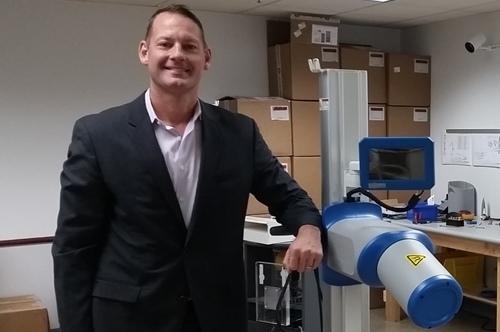Remember when you discovered the mystery of the magnet?
Who among us, as a kid, wasn’t fascinated by the way you could use one magnet to move another across a table without the two ever touching? Or, perhaps you were the owner of a “Wooly Willy”, that toy that allowed you to position metal shavings onto a cartoon face by use of a magnetic “magic wand”.
Magnets, of course, have a much higher purpose than just fun: they’re used in computer screens and credit cards, and among other disciplines, in chemistry and medicine.
And it’s with a medical purpose in mind that a St. Louis startup has unleashed the magic of the magnet.
Pulse Therapeutics’ aim is to use magnets to help clear the blood clots that can cause strokes.
Nearly 90 percent of all stroke cases are caused by blood clots that either originate in or migrate to the artery that feeds the brain, cutting off its supply of oxygen-rich blood. But clearing out those clots is not easy, says Pulse CEO Sean Morris, who uses a pair of plumbing analogies to explain.
Click here to hear Sean Morris’ interview on KMOX Radio St. Louis
“If you have a clog in one of your pipes at home, you use something like Drano to try to break up that blockage,” explains Morris. “But fluid is always going to follow the path of least resistance and so unless you dump it right on top of the blockage, it will be virtually ineffective. If you take a garden hose and you crimp it, there becomes a stagnant column of water from where the water comes in to the crimp in the hose. This stagnant column of water is very hard to penetrate. If you’re using Drano, you have to fight through all that stagnant water,” notes Morris.
“In the case of a stroke, you have free flowing blood in all the arteries your brain, and suddenly, one of those arteries gets clogged by a clot – and that one artery is very important because it is feeding your brain with blood. You’ve got literally millions of other arteries, so when doctors put a clot busting drug into your body, that drug will always follow the path of least resistance. So the question becomes, ‘how is this drug going to get there if there is no flow?’”
The answer, says Morris, is Pulse’s use of magnets.
“Alongside (the clot busting drug) we inject iron particles that are smaller than red blood cells. They’re made to be extremely magnetic. So now these particles are flowing through the blood pool. And little by little by virtue of a small, portable and rapidly spinning magnet placed by the patient’s head, the particles are being pulled out of circulation and into the stagnant column of flow that proceeds a clot. As we spin the magnet at 180 RPM’s, we make little magnetic rotors within the stagnant column of blood, and they’re constantly spinning by virtue of this magnetic field. It helps mix the drug that’s in the main blood pool into the clot,” says Morris. “Those particles are helping deliver the drug, and they’re constantly mixing in new drug.”
Getting effective drugs to the clot quickly is important because when they are deprived of blood, brain tissues begin to die within moments. It’s estimated that 1.9 million neurons die every minute and that for every hour without treatment, a stroke victim’s brain ages more than three years.
Morris says Pulse’s clinical tests on humans in Australia have been promising, adding that the Pulse team has been preparing for the last 18 months to obtain FDA approval to test in humans in this country. His plan is to have those first clinical tests in the U.S. at Barnes Jewish Hospital in St. Louis. In a best case scenario, Morris says the technology would be mainstreamed in the US within four to five years.
Founded in 2008 by physicists Francis “Duke” Creighton and Rogers Ritter, Pulse operates from offices in the T-Rex incubator in downtown St. Louis. Morris joined the team in late 2013, after founding Veniti, another St. Louis life science startup.
While he notes the technology holds all sorts of promise beyond helping stroke patients – it could improve the delivery of cancer-fighting drugs, for example – Morris says Pulse is firmly focused on the present.
“Our intent is to show this works in relation to strokes. If we can focus on the day to day and make this technology work really well, it will increase our options down the road,” he says.
Until then Morris says Pulse will continue to be, “a great St. Louis story. The founder started it here. Most of the investors are from here. I was a CEO with another startup and was recruited to continue on here. Pulse in itself is kind of a small datapoint for how the St. Louis life science community has really grown. Not only has Pulse grown and gotten further down the path, so has St Louis in terms of its ecosystem: the level of passion, the amount of capital. It really is a microcosm of a bigger story,” he says.




Recent Comments